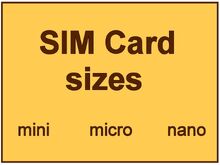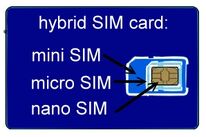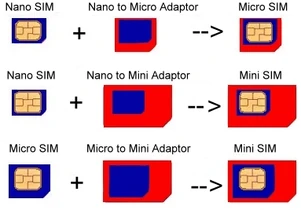
The SIM (= Subscriber Identity Module) card identifies the user in the network. All GSM-based phones use the same size of chip, but the plastic frame around it, comes in 3 different sizes:
- Mini SIM (= 2FF): 25 x 15 mm. This used to be the standard for many years from 1996 and still is the most common size around.
- Micro SIM (= 3FF): 15 x 12 mm. Beginning with iPad and the iPhone 4 in 2010, this smaller size was introduced and more and more new devices are using it now.
- Nano SIM (= 4FF): 12.3 x 8.8 mm. Starting with the iPhone 5 in 2013 an even smaller and 10 % thinner card was introduced. This size is now used in iPhones and iPads, some Nokia, Motorola and Sony phones among others.

In the past, the mini size was the standard size and was often the only size available, but since other manufacturers followed Apple's lead in 2010 by reducing the size of smartphones' SIM card slots, nano SIMs are now easy to find with nearly all operators. Most providers now offer combined double or triple-size cards (also called hybrid cards, see picture) with perforations in the three appropriate sizes. If these are not available, SIM cards can be cut to size by scissors or blades. Sellers are often experienced with it, but you should check whether the SIM still works after being cut.

While oversized cards can only be cut, undersized cards need to be adjusted to a larger size using an 'adaptor', which is just a plastic frame around the chip. So if you have devices which require different SIM sizes, get a SIM in the smallest size you need and add an adaptor frame when using it in other devices. Unfortunately, these frames make you fumble to get the SIM into your device and can be easily lost.
eSIM (embedded SIM)[]
eSIM means embedded SIM whereby the SIM is integrated in the hardware of the device instead of a chip on a removable plastic card. The GSM Association agreed to a common eSIM standard in 2015. They were first developed for M2M (machine-to-machine) applications, but were introduced to some devices in 2016 and to iPhones in 2018.
In future, manufactures intend the space-saving of removing physical SIM cards to reduce the size of their devices. By replacing a physical SIM card, you will no longer need to fumble around with tiny chips. While these aspects sound very good, there are some drawbacks. It's possible that device manufacturers will gradually transition from one or two physical SIM card slots to multiple or additional eSIMs over the next decade.
Operators issue eSIMs in the following ways:
- Directly from the operator's app installed on the user's device. This is common for international SIM providers as it avoids postage costs and allows instant sign-up.
- By sending a QR code by e-mail, typically after proving possession of an existing physical SIM card through an SMS verification code.
- By printing a QR code on paper, similar to a physical SIM card, perhaps by post or by visiting the operator's shop.
The QR code is scanned by the device, which then installs the eSIM's profile on to the device's eSIM. Some operators allow an eSIM's QR code to be used multiple times (e.g. 10 times) consecutively, for example when upgrading one's device, but many allow the QR code to be used only once. If an eSIM's QR code can be used only once and a new QR code can be issued only physically, e.g. by post or by visiting the operator's shop, then this is a significant disadvantage over a physical SIM card, because it means that your physical presence will be required in the country of issue whenever you upgrade your device.
It is possible that operators will in future limit the tariffs available depending on the device used, for example with iPhone-specific tariffs for iPhones. However, there is not yet any evidence of this, and regulators in developed countries could ban such a practice as being anti-competitive.
Until eSIMs become as flexible and ubiquitous as physical SIMs, it's best to avoid devices without any physical SIM card slot and stay with one or two physical slots if you want to continue changing network operators without restrictions. As eSIM-supporting devices can often store multiple eSIM profiles (sometimes misleadingly called "plans") simultaneously, of which only one can be active at once, eSIMs can make switching network operator much faster than with physical SIM cards, which is useful when crossing borders.
iPhone[]
All new iPhones since September 2018 support eSIMs (except in China where they instead have dual nano-SIM), including:
- iPhone XS
- iPhone XR
- iPhone 11
- iPhone SE 2nd generation (aka iPhone SE 2020 or iPhone SE 2)
- iPhone 12
- iPhone 13
Except for the iPhone 13, iPhone have one eSIM and one physical SIM card slot, meaning that one eSIM and one physical SIM card can be active at any one time. The iPhone 13 has two eSIMs and one physical SIM card slot; of these three SIMs, any two can be active at any one time. In all cases, iPhones can store mutliple eSIM profiles, which can allow fast switching between networks, for example when crossing land borders. Although Apple does not publicly state how many eSIM profiles can be stored on one iPhone, some networks, for example Georgia's Magti (requires login), state that iPhones have a maximum capacity of 6 eSIM profiles.
Apple publishes a list of networks that it says support eSIMs in iPhones, but the list is updated infrequently, is missing some known eSIM-supporting networks, and some of the listed networks issue eSIMs only to postpaid customers and not to prepaid customers.
